

What is Oolong tea- production, brewing and common variants. Taiwanese Oolong Compendium. Taiwan has been described by Marshaln as “The Tea Shop Island” and is truly a tea lover’s heaven.
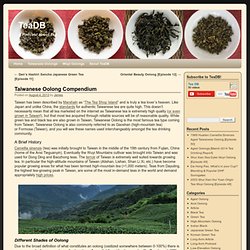
TAiwan+tea+map.jpg. Navigating Through the Diverse World of Oolong Tea. One of the hardest questions I have ever been asked is “what is the typical taste of an oolong?”

Having consumed copious amounts of oolong ranging from diverse varieties, I can’t answer that question without doing grave injustice to my favorite category of tea. It is like trying to give a one line answer to the question “what is a typical Asian lady like”- what your answer includes pales in comparison with what it excludes. While oolong tea is grown primarily in 3 areas- Fujian, Guangdong and Taiwan- its diversity is far greater than say black tea which is grown all over the world but method of production is essentially similar and range of cultivars are less distinct. What gives Oolong its Diversity? Roy Reports from Taiwan: Milk Oolong. After over 30 hours of no sleep, I arrived Taipei at 5:50 AM.
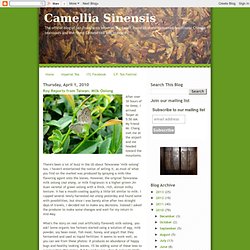
My friend Mr. Chang met me at the airport and we headed toward the mountains. There's been a lot of buzz in the US about Taiwanese "milk oolong" tea. I haven't entertained the notion of selling it, as most of what you find on the market was produced by spraying a milk-like flavoring agent onto the leaves. About Chinese Tea. How Chinese Style Tea is Produced: Processing the Five Major Chinese Tea Types White Tea: White teas are essentially unprocessed.
The tea leaves are simply picked and air dried. Different combinations of sunlight and or low heat are sometimes used to aid the drying process if weather conditions are not optimal at the time of harvest. White teas like Silver Needles are composed entirely of the young buds that are covered in tiny hairs from the tea plants, while Pai Mu Tan style white teas have some buds in them but are composed mainly of large more developed tea leaves. Green Tea: Chinese style green teas involve a little bit more processing than their white counterparts. Pages On White Tea. Recently, I posted a A Challenge: What Are The 10 Most Useful Web Pages On White Tea?. In this post I demonstrated how the pages that come up in a google search for "white tea" are not all high-quality, carefully-maintained websites and articles, and I challenged people to come up with what results they personally would prefer, in their ideal world, to come up. This post shows my ranking.
I know it is really tough and a lot of work to come up with a list like this, but I would like to encourage people to do it, because I think it will have a positive effect on tea culture by helping to draw attention to companies selling high-quality teas, and to websites which contain valuable information. I would also like to encourage people to challenge my list in the comments, providing me with other sites they'd like to see in the list. What Makes A Good Cup Of Chinese Tea? Pu'er by Appearance. This is the permanent residence of a post I made on 22 May 2011. It references this post where I asked people to guess what teas were what based on their appearance. The post details the difference in appearance and taste of young sheng pu'er, young shu pu'er, wet stored aged sheng pu'er, dry stored aged sheng pu'er, and wet stored aged shu pu'er.
Before I begin what is a long post, let me say that of the 9 guesses I received, we had a winner! Unfortunately, said winner chose to post anonymously. For your information, the teas were, from top left to bottom right: young sheng, 90s dry stored sheng, 90s wet stored sheng, young shu, and 90s wet stored shu. What Everybody Ought to Know About Pu-erh Tea. What are the criteria that define the quality of pu-erh tea?
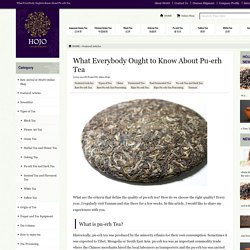
How do we choose the right quality? Every year, I regularly visit Yunnan and stay there for a few weeks. In this article, I would like to share my experiences with you. What is pu-erh Tea? Historically, pu-erh tea was produced by the minority ethnics for their own consumption. Xishuang Banna (西双版納) as a famous pu-erh tea production area Xishuang Banna is situated on the Southern end of Yunnan and it is located at the borders of Myanmar, Vietnam and Laos. Plantations_sm.jpg (683×1024) Japanese Tea Cultivar List. Picture from NARO website There are many Japanese tea cultivars, although in reality only a few are extensively cultivated.
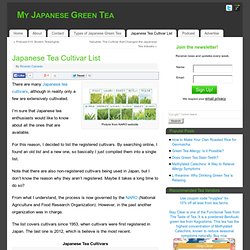
I’m sure that Japanese tea enthusiasts would like to know about all the ones that are available. For this reason, I decided to list the registered cultivars. Tea encyclopedia. What is Tea? Lesson #01 Two leaves and a bud.
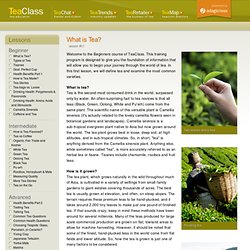
Tea name lists. Tea Harvest Calendar. Throughout the year, the relative positions of the sun and the earth can be expressed by 24 solar terms. Dates marking these 24 solar terms stay almost the same year by year on the international calendar. The 24 solar term marks directed a lot of agricultural activities in traditional society of China, including tea cultivation. On this Tea Harvest Calendar, the harvest dates of various teas are sorted in temporal order based on the solar terms they belong to. More information about the 24 solar terms can be found on this webpage of Hong Kong government: Tea Harvesting Timeline. Seasonality in tea is important. Many tea enthusiasts are beginning to understand that some teas are plucked in only one season of the year, while other teas may be plucked over the course of two or three seasons.
In general, some teas are best when plucked and manufactured in the spring, others in the summer, still others in the fall, and so on. Basic Tea Terminology Pronunciation Guide. Tea names transliterated from the Chinese can be confusing, and lead to many different ideas on pronunciation. David Duckler, founder of Verdant Tea, is also a translator of Chinese fiction and poetry, and names teas according to the principles of translation. First and foremost, the goal is to communicate the same feeling and and information that a Chinese speaker would understand when hearing the name of a tea. Sometimes, a tea’s name is clearly tied to a literal meaning that must be explained. For example, if a sheng pu’er’s name indicated that it was stone pressed, or wild arbor, that is important information to convey in English. Romanization of Chinese Tea Names. Buying, selling, writing, and talking about Chinese tea in the English language can be rather complicated and confusing, owing to uncertainty about the names of teas.
The Chinese language is unfamiliar and alien-sounding to most English speakers, although the base-level of cultural awareness of the Chinese language among the general U.S. population has increased dramatically in recent years. Tea Discovery. TeaClass: Tea education on your own schedule.